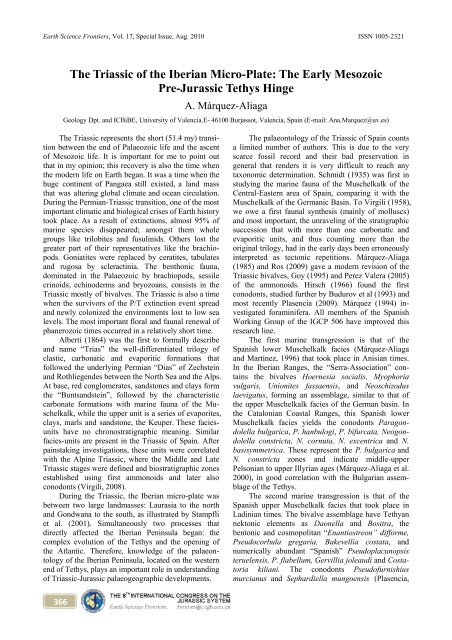in Jurassic and Cretaceous Stratigraphy
in Jurassic and Cretaceous Stratigraphy
in Jurassic and Cretaceous Stratigraphy
Create successful ePaper yourself
Turn your PDF publications into a flip-book with our unique Google optimized e-Paper software.
Earth Science Frontiers, Vol. 17, Special Issue, Aug. 2010 ISSN 1005-2321<br />
366<br />
The Triassic of the Iberian Micro-Plate: The Early Mesozoic<br />
Pre-<strong>Jurassic</strong> Tethys H<strong>in</strong>ge<br />
A. Márquez-Aliaga<br />
Geology Dpt. <strong>and</strong> ICBiBE, University of Valencia.E- 46100 Burjassot, Valencia, Spa<strong>in</strong> (E-mail: Ana.Marquez@uv.es)<br />
The Triassic represents the short (51.4 my) transi-<br />
tion between the end of Palaeozoic life <strong>and</strong> the ascent<br />
of Mesozoic life. It is important for me to po<strong>in</strong>t out<br />
that <strong>in</strong> my op<strong>in</strong>ion; this recovery is also the time when<br />
the modern life on Earth began. It was a time when the<br />
huge cont<strong>in</strong>ent of Pangaea still existed, a l<strong>and</strong> mass<br />
that was alter<strong>in</strong>g global climate <strong>and</strong> ocean circulation.<br />
Dur<strong>in</strong>g the Permian-Triassic transition, one of the most<br />
important climatic <strong>and</strong> biological crises of Earth history<br />
took place. As a result of ext<strong>in</strong>ctions, almost 95% of<br />
mar<strong>in</strong>e species disappeared; amongst them whole<br />
groups like trilobites <strong>and</strong> fusul<strong>in</strong>ids. Others lost the<br />
greater part of their representatives like the brachio-<br />
pods. Goniatites were replaced by ceratites, tabulates<br />
<strong>and</strong> rugosa by scleract<strong>in</strong>ia. The benthonic fauna,<br />
dom<strong>in</strong>ated <strong>in</strong> the Palaeozoic by brachiopods, sessile<br />
cr<strong>in</strong>oids, ech<strong>in</strong>oderms <strong>and</strong> bryozoans, consists <strong>in</strong> the<br />
Triassic mostly of bivalves. The Triassic is also a time<br />
when the survivors of the P/T ext<strong>in</strong>ction event spread<br />
<strong>and</strong> newly colonized the environments lost to low sea<br />
levels. The most important floral <strong>and</strong> faunal renewal of<br />
phanerozoic times occurred <strong>in</strong> a relatively short time.<br />
Alberti (1864) was the first to formally describe<br />
<strong>and</strong> name “Trias” the well-differentiated trilogy of<br />
clastic, carbonatic <strong>and</strong> evaporitic formations that<br />
followed the underly<strong>in</strong>g Permian “Dias” of Zechste<strong>in</strong><br />
<strong>and</strong> Rothliegendes between the North Sea <strong>and</strong> the Alps.<br />
At base, red conglomerates, s<strong>and</strong>stones <strong>and</strong> clays form<br />
the “Bunts<strong>and</strong>ste<strong>in</strong>”, followed by the characteristic<br />
carbonate formations with mar<strong>in</strong>e fauna of the Mu-<br />
schelkalk, while the upper unit is a series of evaporites,<br />
clays, marls <strong>and</strong> s<strong>and</strong>stone, the Keuper. These facies-<br />
units have no chronostratigraphic mean<strong>in</strong>g. Similar<br />
facies-units are present <strong>in</strong> the Triassic of Spa<strong>in</strong>. After<br />
pa<strong>in</strong>stak<strong>in</strong>g <strong>in</strong>vestigations, these units were correlated<br />
with the Alp<strong>in</strong>e Triassic, where the Middle <strong>and</strong> Late<br />
Triassic stages were def<strong>in</strong>ed <strong>and</strong> biostratigraphic zones<br />
established us<strong>in</strong>g first ammonoids <strong>and</strong> later also<br />
conodonts (Virgili, 2008).<br />
Dur<strong>in</strong>g the Triassic, the Iberian micro-plate was<br />
between two large l<strong>and</strong>masses: Laurasia to the north<br />
<strong>and</strong> Gondwana to the south, as illustrated by Stampfli<br />
et al. (2001). Simultaneously two processes that<br />
directly affected the Iberian Pen<strong>in</strong>sula began: the<br />
complex evolution of the Tethys <strong>and</strong> the open<strong>in</strong>g of<br />
the Atlantic. Therefore, knowledge of the palaeon-<br />
tology of the Iberian Pen<strong>in</strong>sula, located on the western<br />
end of Tethys, plays an important role <strong>in</strong> underst<strong>and</strong><strong>in</strong>g<br />
of Triassic-<strong>Jurassic</strong> palaeogeographic developments.<br />
The palaeontology of the Triassic of Spa<strong>in</strong> counts<br />
a limited number of authors. This is due to the very<br />
scarce fossil record <strong>and</strong> their bad preservation <strong>in</strong><br />
general that renders it is very difficult to reach any<br />
taxonomic determ<strong>in</strong>ation. Schmidt (1935) was first <strong>in</strong><br />
study<strong>in</strong>g the mar<strong>in</strong>e fauna of the Muschelkalk of the<br />
Central-Eastern area of Spa<strong>in</strong>, compar<strong>in</strong>g it with the<br />
Muschelkalk of the Germanic Bas<strong>in</strong>. To Virgili (1958),<br />
we owe a first faunal synthesis (ma<strong>in</strong>ly of molluscs)<br />
<strong>and</strong> most important, the unravel<strong>in</strong>g of the stratigraphic<br />
succession that with more than one carbonatic <strong>and</strong><br />
evaporitic units, <strong>and</strong> thus count<strong>in</strong>g more than the<br />
orig<strong>in</strong>al trilogy, had <strong>in</strong> the early days been erroneously<br />
<strong>in</strong>terpreted as tectonic repetitions. Márquez-Aliaga<br />
(1985) <strong>and</strong> Ros (2009) gave a modern revision of the<br />
Triassic bivalves, Goy (1995) <strong>and</strong> Perez Valera (2005)<br />
of the ammonoids. Hirsch (1966) found the first<br />
conodonts, studied further by Budurov et al (1993) <strong>and</strong><br />
most recently Plasencia (2009). Márquez (1994) <strong>in</strong>-<br />
vestigated foram<strong>in</strong>ifera. All members of the Spanish<br />
Work<strong>in</strong>g Group of the IGCP 506 have improved this<br />
research l<strong>in</strong>e.<br />
The first mar<strong>in</strong>e transgression is that of the<br />
Spanish lower Muschelkalk facies (Márquez-Aliaga<br />
<strong>and</strong> Martínez, 1996) that took place <strong>in</strong> Anisian times.<br />
In the Iberian Ranges, the “Serra-Association” con-<br />
ta<strong>in</strong>s the bivalves Hoernesia socialis, Myophoria<br />
vulgaris, Unionites fassaensis, <strong>and</strong> Neoschizodus<br />
laevigatus, form<strong>in</strong>g an assemblage, similar to that of<br />
the upper Muschelkalk facies of the German bas<strong>in</strong>. In<br />
the Catalonian Coastal Ranges, this Spanish lower<br />
Muschelkalk facies yields the conodonts Paragon-<br />
dolella bulgarica, P. hanbulogi, P. bifurcata, Neogon-<br />
dolella constricta, N. cornuta, N. excentrica <strong>and</strong> N.<br />
basisymmetrica. These represent the P. bulgarica <strong>and</strong><br />
N. constricta zones <strong>and</strong> <strong>in</strong>dicate middle-upper<br />
Pelsonian to upper Illyrian ages (Márquez-Aliaga et al.<br />
2000), <strong>in</strong> good correlation with the Bulgarian assem-<br />
blage of the Tethys.<br />
The second mar<strong>in</strong>e transgression is that of the<br />
Spanish upper Muschelkalk facies that took place <strong>in</strong><br />
Lad<strong>in</strong>ian times. The bivalve assemblage have Tethyan<br />
nektonic elements as Daonella <strong>and</strong> Bositra, the<br />
bentonic <strong>and</strong> cosmopolitan “Enantiostreon” difforme,<br />
Pseudocorbula gregaria, Bakevellia costata, <strong>and</strong><br />
numerically abundant “Spanish” Pseudoplacunopsis<br />
teruelensis, P. flabellum, Gervillia joleaudi <strong>and</strong> Costa-<br />
toria kiliani. The conodonts Pseudofurnishius<br />
murcianus <strong>and</strong> Sephardiella mungoensis (Plasencia,

















